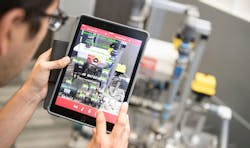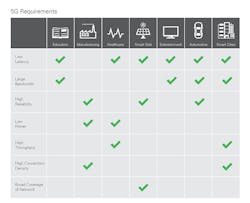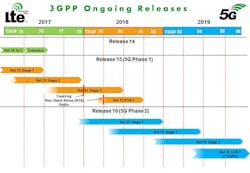December 2017 marked an important milestone for the next generation of wireless standards—the first half of the phase 1 5G New Radio (5G NR) standard was ratified by the 3GPP. And another milestone is quickly approaching in June of this year to ratify the second half of phase 1 5G NR. As the standards are finalized, commercial devices and infrastructure built around this released standard are going through field trials and pre-release testing. All of this means the commercial rollout of 5G is getting close.
At Mobile World Congress in February, numerous 5G demonstrations were touting the high speeds promised and showing off flashy applications like VR. Comparing Mobile World Congress 2018 to 2017, the advances in technology are impressive to say the least. One of the most impressive aspects of 5G is that it isn’t just a new mobile standard. There is a entire ecosystem being built up around the standard encompassing a broad range of industries and applications.
Unlike previous standards, the 5G standard intentionally includes performance metrics in it to enable applications other than traditional mobile broadband use cases. There’s a performance metric for improvements to the enhanced mobile broadband in 5G, of course, but additional performance metrics exist for increasing the number of devices to simultaneously connect to the network. In addition, there’s a specification for latency.
The increased device connectivity will help to enable the Internet of Things (IoT) and the Industrial Internet of Things (IIoT) on a scale that can’t be realized by today’s LTE capabilities alone. The latency specification will allow for applications where deterministic communication is necessary (think any application where a human life is involved) or when the technology will interact in real time with humans. While each of these 3 areas of specification enable new and expanded use cases, it’s the combination of all three together that is creating a rich ecosystem of applications around 5G. Figure 1 shows how different applications will take advantage of different performance aspects of 5G is shown below.
1. Many wireless applications require the features provided by 5G.
Keeping Up with Standards and New Releases
As mentioned above, 3GPP’s standard release in December is just the first of many releases (Fig. 2). 5G will follow a similar design cycle as LTE. There have been multiple releases and many updates to standards for LTE over the past nine years since its inception. LTE was first introduced in 3GPP release 8. Currently, the 3GPP is working to finalize release 15, which will include the 5G NR specifications.
In December, there was a freeze for a specific use case for 5G NR called the Non-Stand Alone (NSA) use case. When release 15 is frozen in June 2018, it will include 5G NR NSA, as well as specifications for the Stand Alone (SA) use case. The NSA use case of 5G NR is important because it will operate by using the core network from LTE. This means that new infrastructure needn’t be rolled out and installed to operate 5G NR NSA. The SA version will use a 5G core network and will most likely require new network equipment to be installed.
2. The 3GPP release timeline highlights 5G’s standards process.
Over the course of the next several months, researchers will be working diligently to finalize the standard for the 5G NR SA use case. And equipment vendors will be designing hardware that will be able to support the stand alone use case once it is released.
2018 will be an exciting year for the 5G. In addition to the 3GPP wrapping up release 15, there will also be more early deployments of 5G into the consumer market. At Mobil World Congress, Huawei demonstrated a 5G base station, Samsung demonstrated Interoperability Device Testing (IODT) with its 28-GHz 5G NR base station, and Qualcomm had an IODT demonstration for its 28-GHz capable UE with base stations from Ericsson and Nokia. These demonstrations show that equipment vendors have hardware that’s almost ready to be deployed, and Qualcomm states in bold lettering on its website that the company is working to make 5G a commercial reality in 2019.
Triggering a New Tech Revolution
As 5G starts to roll out and become broadly available, a whole host of new technologies and applications built around 5G will also begin to emerge. 5G’s unique charter to add latency and capacity provisions to the official specification start to make it possible to achieve applications that sounded futuristic just a few years ago.
A perfect example of this is virtual reality (VR). To have a full VR experience, a few key “care-abouts” need to be considered. First, users will want a full 360-degree, high-definition view of their virtual world to explore. This means that cameras must be constantly capturing 360 degrees worth of high-definition video. Those videos must then be streamed from the camera location back to the cellular base station. From there, they must then be streamed to the end user. The high data rates that 5G promises are easily able to accomplish this task and provide enough throughput to stream to multiple users simultaneously.
The other very important aspect of VR is latency. If someone has a VR headset on and he or she turns their head, the virtual environment around them also needs to turn in under 1 ms. If the latency is greater than 1 ms, the human brain detects this latency and most people experience severe nausea. Because of the combined improved mobile broadband speeds and the sub-1-ms latency specification in 5G, VR over a cellular network will be possible.
Virtual reality has been around in some form for years, but the ability to have VR over a cellular network will make possible new applications for VR. One hot application for VR is sporting events. Imagine being able to experience a football game from the perspective of one of the players on the field. Or to virtually stand at the 50-yard line and watch the action happening live all around you.
3. Intel’s TrueVR system for the 2018 Winter Olympics highlights the need, and demand, for high-speed wireless technology.
A small-scale demo of this type of technology occurred at the PyeongChang Olympics earlier this year (Fig. 3). One hundred cameras were placed in the skating rink and the data was live-streamed back to a 5G technology pavilion. People in the pavilion could put on VR headsets and experience events as if they were performing them.
Impact on IoT and IIoT
5G’s ability to connect 100 times more devices to the network will allow for the Internet of Things (IoT) and the Industrial Internet of Things (IIoT) to really take off. IoT exists to some extent today, and more devices coming on the market are connected to the internet.
For consumers, these devices range from helpful to interesting to straight up weird. But for industry, the IIoT offers exciting new features and functionality for smart factories. When every machine and device in a manufacturing plant can constantly report its health statistics and efficiency, aging equipment can be repaired before it breaks down and potentially avoid problems altogether.
By combining the IIoT with augmented reality (AR), machine learning, and artificial intelligence (AI), technicians will be able to view machinery status and information through AR goggles or on a tablet in the field, and AI can help to quickly diagnose problems (Fig. 4). Overall, 5G has the potential to make future manufacturing faster, cheaper, and safer.
4. High-speed wireless will be key to the success of augmented-reality IIoT, in an effort to create smart factories.
Driving Autonomous-Vehicle Advances
Autonomous vehicles are probably one of the hottest and most anticipated applications that will be enabled by 5G. Currently, vehicles that operate autonomously do so by using a combination of different sensors and photo and video processing. Future self-driving cars will still need to be equipped with numerous sensors and be able to process data from the sensors, but adding vehicular communications is necessary to make self-driving cars successful on a large scale. To put it simply, vehicles will need a way to communicate with each other. Vehicle-to-vehicle (V2V) communications will be used to share data about road and environment conditions, as well as route information such as anticipating stops or left turns.
In addition, vehicles will need to be able to communicate with a number of different types of devices like cellular base stations and other smart devices such as a smart lamppost or street sign that could transmit road conditions or environmental data to passing vehicles. The body of research around this is called vehicle to everything (V2X) communications. The latency aspect of 5G will be critical for getting information to vehicles. For example, not braking quickly enough to respond to an object in the road due to too much latency in the communications link could cause injury or death for the passengers in the vehicle. Thus, ultra-reliable communications for V2X is a must.
The massive data throughput in 5G will also play an important part in V2X. A car at a traffic light could download and upload information about its current location from a nearby base station. This allows the car to be a collector of sensor data, but the processing can be down at the base station or potentially in the cloud. As processing technology improves, updates can be pushed to cellular infrastructure, and older cars would still be able to take advantage of these updates without needing changes to their hardware.
While the current revision of the 3GPP specification doesn’t include any specifications for V2X, 5G is an evolving standard, and the December 2017 release is just the first of many. The timeline in Fig. 2 shows plans for release 16 at the end of 2019, and this release represents phase 2 of 5G NR.
Current study items stated for exploration during phase 2 include Integrated Access Backhaul (IAB) for centralized backhaul processing, addressing the challenges of sharing unlicensed spectrum for mobile communications, and V2X. The 3GPP aims to address these topics and a host of others during phase 2. Although 5G will be rolling out into commercial products in late 2018 and 2019, the research phase of 5G is still ongoing.
As 5G standards are solidified and 5G-capable devices start coming to market, we will increasingly feel the global impact of 5G. It will be an integral part of many aspects of daily life, from entertainment to smart cities. It is assuredly just the start of an exciting and new era of wireless technology.
Sarah Yost is Senior Product Manager at National Instruments.
About the Author
Sarah Yost
Senior Solutions Marketing Manager, SDR
Sarah is a senior solutions marketing manager on the software-defined radio (SDR) team at NI. She manages NI’s mmWave SDR products. In addition to product management, Sarah works with NI’s advanced wireless research team studying and promoting 5G wireless technology. Prior to joining the SDR marketing, Sarah spent time working as a part of the Ettus Research R&D team, gaining a deep knowledge of SDR hardware and software. Sarah’s background is in microwave and millimeter-wave technology, specifically for wireless communications.
Sarah has a BS in electrical engineering from Texas Tech University.





